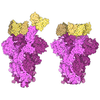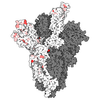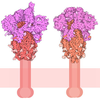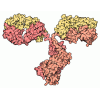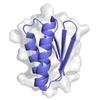[English] 日本語
 Yorodumi
Yorodumi- PDB-8elj: SARS-CoV-2 spike glycoprotein in complex with the ICO-hu23 neutra... -
+ Open data
Open data
- Basic information
Basic information
| Entry | Database: PDB / ID: 8elj | ||||||
|---|---|---|---|---|---|---|---|
| Title | SARS-CoV-2 spike glycoprotein in complex with the ICO-hu23 neutralizing antibody Fab fragment | ||||||
 Components Components |
| ||||||
 Keywords Keywords | VIRAL PROTEIN/IMMUNE SYSTEM / Complex / antibody / VIRAL PROTEIN-IMMUNE SYSTEM complex | ||||||
| Function / homology |  Function and homology information Function and homology informationMaturation of spike protein / viral translation / Translation of Structural Proteins / Virion Assembly and Release / host cell surface / host extracellular space / symbiont-mediated-mediated suppression of host tetherin activity / Induction of Cell-Cell Fusion / structural constituent of virion / entry receptor-mediated virion attachment to host cell ...Maturation of spike protein / viral translation / Translation of Structural Proteins / Virion Assembly and Release / host cell surface / host extracellular space / symbiont-mediated-mediated suppression of host tetherin activity / Induction of Cell-Cell Fusion / structural constituent of virion / entry receptor-mediated virion attachment to host cell / membrane fusion / Attachment and Entry / host cell endoplasmic reticulum-Golgi intermediate compartment membrane / positive regulation of viral entry into host cell / receptor-mediated virion attachment to host cell / host cell surface receptor binding / symbiont-mediated suppression of host innate immune response / receptor ligand activity / endocytosis involved in viral entry into host cell / fusion of virus membrane with host plasma membrane / fusion of virus membrane with host endosome membrane / viral envelope / virion attachment to host cell / SARS-CoV-2 activates/modulates innate and adaptive immune responses / host cell plasma membrane / virion membrane / identical protein binding / membrane / plasma membrane Similarity search - Function | ||||||
| Biological species |   Homo sapiens (human) Homo sapiens (human) | ||||||
| Method | ELECTRON MICROSCOPY / single particle reconstruction / cryo EM / Resolution: 3.6 Å | ||||||
 Authors Authors | Yee, A.W. / Morizumi, T. / Kim, K. / Kuo, A. / Ernst, O.P. | ||||||
| Funding support |  Canada, 1items Canada, 1items
| ||||||
 Citation Citation |  Journal: PLoS Pathog / Year: 2023 Journal: PLoS Pathog / Year: 2023Title: Broadly neutralizing humanized SARS-CoV-2 antibody binds to a conserved epitope on Spike and provides antiviral protection through inhalation-based delivery in non-human primates. Authors: Paule Hermet / Benoît Delache / Cecile Herate / Esther Wolf / Gaily Kivi / Erkki Juronen / Karl Mumm / Eva Žusinaite / Denis Kainov / Eve Sankovski / Kai Virumäe / Anu Planken / Andres ...Authors: Paule Hermet / Benoît Delache / Cecile Herate / Esther Wolf / Gaily Kivi / Erkki Juronen / Karl Mumm / Eva Žusinaite / Denis Kainov / Eve Sankovski / Kai Virumäe / Anu Planken / Andres Merits / Jessica E Besaw / Ai Woon Yee / Takefumi Morizumi / Kyumhyuk Kim / Anling Kuo / Asma Berriche / Nathalie Dereuddre-Bosquet / Quentin Sconosciuti / Thibaut Naninck / Francis Relouzat / Mariangela Cavarelli / Mart Ustav / Derek Wilson / Oliver P Ernst / Andres Männik / Roger LeGrand / Mart Ustav /     Abstract: The COVID-19 pandemic represents a global challenge that has impacted and is expected to continue to impact the lives and health of people across the world for the foreseeable future. The rollout of ...The COVID-19 pandemic represents a global challenge that has impacted and is expected to continue to impact the lives and health of people across the world for the foreseeable future. The rollout of vaccines has provided highly anticipated relief, but effective therapeutics are required to further reduce the risk and severity of infections. Monoclonal antibodies have been shown to be effective as therapeutics for SARS-CoV-2, but as new variants of concern (VoC) continue to emerge, their utility and use have waned due to limited or no efficacy against these variants. Furthermore, cumbersome systemic administration limits easy and broad access to such drugs. As well, concentrations of systemically administered antibodies in the mucosal epithelium, a primary site of initial infection, are dependent on neonatal Fc receptor mediated transport and require high drug concentrations. To reduce the viral load more effectively in the lung, we developed an inhalable formulation of a SARS-CoV-2 neutralizing antibody binding to a conserved epitope on the Spike protein, ensuring pan-neutralizing properties. Administration of this antibody via a vibrating mesh nebulization device retained antibody integrity and resulted in effective distribution of the antibody in the upper and lower respiratory tract of non-human primates (NHP). In comparison with intravenous administration, significantly higher antibody concentrations can be obtained in the lung, resulting in highly effective reduction in viral load post SARS-CoV-2 challenge. This approach may reduce the barriers of access and uptake of antibody therapeutics in real-world clinical settings and provide a more effective blueprint for targeting existing and potentially emerging respiratory tract viruses. | ||||||
| History |
|
- Structure visualization
Structure visualization
| Structure viewer | Molecule:  Molmil Molmil Jmol/JSmol Jmol/JSmol |
|---|
- Downloads & links
Downloads & links
- Download
Download
| PDBx/mmCIF format |  8elj.cif.gz 8elj.cif.gz | 751.9 KB | Display |  PDBx/mmCIF format PDBx/mmCIF format |
|---|---|---|---|---|
| PDB format |  pdb8elj.ent.gz pdb8elj.ent.gz | 600.8 KB | Display |  PDB format PDB format |
| PDBx/mmJSON format |  8elj.json.gz 8elj.json.gz | Tree view |  PDBx/mmJSON format PDBx/mmJSON format | |
| Others |  Other downloads Other downloads |
-Validation report
| Summary document |  8elj_validation.pdf.gz 8elj_validation.pdf.gz | 1.7 MB | Display |  wwPDB validaton report wwPDB validaton report |
|---|---|---|---|---|
| Full document |  8elj_full_validation.pdf.gz 8elj_full_validation.pdf.gz | 1.8 MB | Display | |
| Data in XML |  8elj_validation.xml.gz 8elj_validation.xml.gz | 106.4 KB | Display | |
| Data in CIF |  8elj_validation.cif.gz 8elj_validation.cif.gz | 157 KB | Display | |
| Arichive directory |  https://data.pdbj.org/pub/pdb/validation_reports/el/8elj https://data.pdbj.org/pub/pdb/validation_reports/el/8elj ftp://data.pdbj.org/pub/pdb/validation_reports/el/8elj ftp://data.pdbj.org/pub/pdb/validation_reports/el/8elj | HTTPS FTP |
-Related structure data
| Related structure data |  28228MC  8el2C M: map data used to model this data C: citing same article ( |
|---|---|
| Similar structure data | Similarity search - Function & homology  F&H Search F&H Search |
- Links
Links
- Assembly
Assembly
| Deposited unit | 
|
|---|---|
| 1 |
|
- Components
Components
| #1: Protein | Mass: 139234.109 Da / Num. of mol.: 3 Source method: isolated from a genetically manipulated source Source: (gene. exp.)  Gene: S, 2 / Production host:  #2: Antibody | Mass: 25479.584 Da / Num. of mol.: 3 Source method: isolated from a genetically manipulated source Source: (gene. exp.)  Homo sapiens (human) / Production host: Homo sapiens (human) / Production host:  #3: Antibody | Mass: 22802.115 Da / Num. of mol.: 3 Source method: isolated from a genetically manipulated source Source: (gene. exp.)  Homo sapiens (human) / Production host: Homo sapiens (human) / Production host:  #4: Polysaccharide | 2-acetamido-2-deoxy-beta-D-glucopyranose-(1-4)-2-acetamido-2-deoxy-beta-D-glucopyranose Source method: isolated from a genetically manipulated source #5: Sugar | ChemComp-NAG / Has ligand of interest | N | Has protein modification | Y | |
|---|
-Experimental details
-Experiment
| Experiment | Method: ELECTRON MICROSCOPY |
|---|---|
| EM experiment | Aggregation state: PARTICLE / 3D reconstruction method: single particle reconstruction |
- Sample preparation
Sample preparation
| Component |
| ||||||||||||||||||||||||
|---|---|---|---|---|---|---|---|---|---|---|---|---|---|---|---|---|---|---|---|---|---|---|---|---|---|
| Source (natural) |
| ||||||||||||||||||||||||
| Source (recombinant) |
| ||||||||||||||||||||||||
| Buffer solution | pH: 8 | ||||||||||||||||||||||||
| Buffer component |
| ||||||||||||||||||||||||
| Specimen | Conc.: 0.38 mg/ml / Embedding applied: NO / Shadowing applied: NO / Staining applied: NO / Vitrification applied: YES | ||||||||||||||||||||||||
| Specimen support | Grid material: COPPER / Grid mesh size: 300 divisions/in. / Grid type: C-flat-2/1 | ||||||||||||||||||||||||
| Vitrification | Instrument: FEI VITROBOT MARK IV / Cryogen name: ETHANE / Humidity: 100 % / Chamber temperature: 298 K |
- Electron microscopy imaging
Electron microscopy imaging
| Experimental equipment |  Model: Titan Krios / Image courtesy: FEI Company |
|---|---|
| Microscopy | Model: FEI TITAN KRIOS |
| Electron gun | Electron source:  FIELD EMISSION GUN / Accelerating voltage: 300 kV / Illumination mode: OTHER FIELD EMISSION GUN / Accelerating voltage: 300 kV / Illumination mode: OTHER |
| Electron lens | Mode: BRIGHT FIELD / Nominal magnification: 105000 X / Nominal defocus max: 2500 nm / Nominal defocus min: 1250 nm |
| Specimen holder | Cryogen: NITROGEN / Specimen holder model: FEI TITAN KRIOS AUTOGRID HOLDER |
| Image recording | Electron dose: 80 e/Å2 / Film or detector model: GATAN K3 (6k x 4k) |
- Processing
Processing
| EM software |
| ||||||||||||||||
|---|---|---|---|---|---|---|---|---|---|---|---|---|---|---|---|---|---|
| CTF correction | Type: PHASE FLIPPING AND AMPLITUDE CORRECTION | ||||||||||||||||
| Symmetry | Point symmetry: C3 (3 fold cyclic) | ||||||||||||||||
| 3D reconstruction | Resolution: 3.6 Å / Resolution method: FSC 0.143 CUT-OFF / Num. of particles: 35845 / Symmetry type: POINT | ||||||||||||||||
| Atomic model building | Protocol: RIGID BODY FIT / Space: REAL | ||||||||||||||||
| Atomic model building | PDB-ID: 6VXX Accession code: 6VXX / Source name: PDB / Type: experimental model |
 Movie
Movie Controller
Controller


 PDBj
PDBj